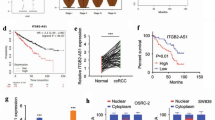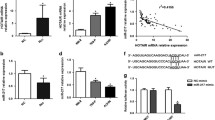Abstract
Increasing evidence has demonstrated that small non-coding microRNAs (miRNAs) play important roles in cancer development and progression. Recent studies have shown that microRNA-335 (miR-335) functions as an oncogene or a tumor suppressor in various human cancer types, but its role in clear cell renal cell carcinoma (ccRCC) remains poorly understood. In our study, we firstly found that the expression level of miR-335 was significantly downregulated in ccRCC tissues versus corresponding non-tumor tissues and the low expression of miR-335 was significantly associated with lymph node metastasis, larger tumor size, and poor T stage. Then, we found that overexpression of miR-335 significantly suppressed the proliferation and invasion of 786-O and CaKi-1 ccRCC cell lines. We subsequently found that miR-335 could interact with the 3′-untranslated regions (3′UTR) of B-cell CLL/lymphoma 2 like 2 (BCL-W or BCL2L2) messenger RNA (mRNA) and repress its expression. In addition, re-expression of BCL-W (without the 3′UTR) could partially abrogate the miR-335-induced 786-O and CaKi-1 ccRCC cell proliferation and invasion inhibition. Furthermore, we found that expression patterns of miR-335 were inversely correlated with those of BCL-W mRNA in ccRCC tissues. Taken together, these results indicate that miR-335 acts as a novel tumor suppressor to regulate ccRCC cell proliferation and invasion through downregulation of BCL-W expression.




Similar content being viewed by others
References
Jemal A, Bray F, Center MM, et al. Global cancer statistics. CA Cancer J Clin. 2011;61:69–90.
Cohen HT, McGovern FJ. Renal-cell carcinoma. N Engl J Med. 2005;353(23):2477–90.
Park K, Lee JL, Park I, et al. Comparative efficacy of vascular endothelial growth factor (VEGF) tyrosine kinase inhibitor (TKI) and mammalian target of rapamycin (mTOR) inhibitor as second-line therapy in patients with metastatic renal cell carcinoma after the failure of first-line VEGF TKI. Med Oncol. 2012;29(5):3291–7.
Inui M, Martello G, Piccolo S. MicroRNA control of signal transduction. Nat Rev Mol Cell Biol. 2010;11:252–63.
Khella HW, White NM, Faragalla H, et al. Exploring the role of miRNAs in renal cell carcinoma progression and metastasis through bioinformatic and experimental analyses. Tumor Biol. 2012;33:131–40.
Asangani IA, Rasheed SA, Nikolova DA, et al. MicroRNA-21 (miR-21) post-transcriptionally downregulates tumor suppressor Pdcd4 and stimulates invasion, intravasation and metastasis in colorectal cancer. Oncogene. 2008;27(15):2128–36.
Kong W, He L, Richards EJ, et al. Upregulation of miRNA-155 promotes tumour angiogenesis by targeting VHL and is associated with poor prognosis and triple-negative breast cancer. Oncogene. 2014;33(6):679–89.
Shu M, Zhou Y, Zhu W, et al. MicroRNA-335 is required for differentiation of malignant glioma cells induced by activation of cAMP/protein kinase A pathway. Mol Pharmacol. 2012;81(3):292–8.
Tavazoie SF, Alarcón C, Oskarsson T, et al. Endogenous human microRNAs that suppress breast cancer metastasis. Nature. 2008;451(7175):147–52.
Wang F, Zheng Z, Guo J, et al. Correlation and quantitation of microRNA aberrant expression in tissues and sera from patients with breast tumor. Gynecol Oncol. 2010;119(3):586–93.
Gao Y, Zeng F, Wu JY, et al. MiR-335 inhibits migration of breast cancer cells through targeting oncoprotein c-Met. Tumour Biol. 2014.
Sorrentino A, Liu CG, Addario A, et al. Role of microRNAs in drug-resistant ovarian cancer cells. Gynecol Oncol. 2008;111(3):478–86.
Gao L, Yang Y, Xu H, et al. MiR-335 functions as a tumor suppressor in pancreatic cancer by targeting OCT4. Tumour Biol. 2014;35(8):8309–18.
Wang H, Li M, Zhang R, et al. Effect of miR-335 upregulation on the apoptosis and invasion of lung cancer cell A549 and H1299. Tumour Biol. 2013;34(5):3101–9.
Xiong SW, Lin TX, Xu KW, et al. MicroRNA-335 acts as a candidate tumor suppressor in prostate cancer. Pathol Oncol Res. 2013;19(3):529–37.
Yan Z, Xiong Y, Xu W, et al. Identification of hsa-miR-335 as a prognostic signature in gastric cancer. PLoS One. 2012;7(7):e40037.
Shu M, Zheng X, Wu S, et al. Targeting oncogenic miR-335 inhibits growth and invasion of malignant astrocytoma cells. Mol Cancer. 2011;10:59.
Shi L, Jiang D, Sun G, et al. miR-335 promotes cell proliferation by directly targeting Rb1 in meningiomas. Neuro-Oncology. 2012;110(2):155–62.
Ren KM, Bai JX, Wang SN, et al. Identification of potential biomarkers for clear cell renal cell carcinoma based on microRNA-mRNA pathway relationships. J Cancer Res Ther. 2014;10(Suppl):C167–77.
Hidaka H, Seki N, Yoshino H, et al. Tumor suppressive microRNA-1285 regulates novel molecular targets: aberrant expression and functional significance in renal cell carcinoma. Oncotarget. 2012;3(1):44–57.
White NM, Bao TT, Grigull J, et al. miRNA profiling for clear cell renal cell carcinoma: biomarker discovery and identification of potential controls and consequences of miRNA dysregulation. J Urol. 2011;186(3):1077–83.
Shen L, Li J, Xu L, et al. miR-497 induces apoptosis of breast cancer cells by targeting BCL-W. Exp Ther Med. 2012;3(3):475–80.
Cao J, Cai J, Huang D, et al. miR-335 represents an invasion suppressor gene in ovarian cancer by targeting BCL-W. Oncol Rep. 2013;30(2):701–6.
Xu Y, Zhao F, Wang Z, et al. MicroRNA-335 acts as a metastasis suppressor in by targeting BCL-W and specificity protein 1. Oncogene. 2012;31(11):1398–407.
Edge SB, Byrd DR, Compton CC, et al. AJCC cancer staging manual. 7th ed. New York: Springer; 2010.
Livak KJ, Schmittgen TD. Analysis of relative gene expression data using real-time quantitative PCR and the 2(-Delta Delta C(T)) method. Methods. 2001;25(4):402–8.
Yates LA, Norbury CJ, Gilbert RJ. The long and short of microRNA. Cell. 2013;153(3):516–9.
Dassow H, Aigner A. MicroRNAs (miRNAs) in colorectal cancer: from aberrant expression towards therapy. Curr Pharm Des. 2013;19(7):1242–52.
Gross A, McDonnell JM, Korsmeyer SJ. BCL-2 family members and the mitochondria in apoptosis. Genes Dev. 1999;13(15):1899–911.
Antonsson B. Bax and other pro-apoptotic Bcl-2 family “killer-proteins” and their victim the mitochondrion. Cell Tissue Res. 2001;306(3):347–61.
Uren RT, Dewson G, Chen L, et al. Mitochondrial permeabilization relies on BH3 ligands engaging multiple prosurvival Bcl-2 relatives, not Bak. J Cell Biol. 2007;177(2):277–87.
Bae IH, Yoon SH, Lee SB, et al. Signaling components involved in BCL-W-induced migration of gastric cancer cells. Cancer Lett. 2009;277(1):22–8.
Lee HW, Lee SS, Lee SJ, et al. BCL-W is expressed in a majority of infiltrative gastric adenocarcinomas and suppresses the cancer cell death by blocking stress-activated protein kinase/c-Jun NH2-terminal kinase activation. Cancer Res. 2003;63(5):1093–100.
Acknowledgments
This work was supported by grants from the General Science Research Program of the Education Department of Liaoning Province in China (No. L2014310).
Conflicts of interest
None
Author information
Authors and Affiliations
Corresponding author
Rights and permissions
About this article
Cite this article
Wang, K., Chen, X., Zhan, Y. et al. miR-335 inhibits the proliferation and invasion of clear cell renal cell carcinoma cells through direct suppression of BCL-W . Tumor Biol. 36, 6875–6882 (2015). https://doi.org/10.1007/s13277-015-3382-6
Received:
Accepted:
Published:
Issue Date:
DOI: https://doi.org/10.1007/s13277-015-3382-6




